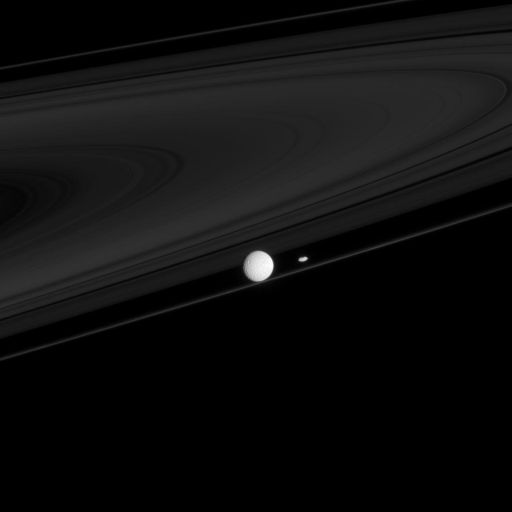Emily Lakdawalla • Dec 10, 2008
Mimas, Prometheus, and the rings
I'm almost entirely cut off from the world today -- by which I mean my home Internet access is down. And the wireless network at my local public library is down. So I'm using a terminal at the library with a horrible sticky keyboard. Which means it's not going to be a productive day. The best thing for me to post on this kind of day is go look for a pretty picture and share it with you. So, I wandered to the Photojournal and decided that my favorite recent image is this one taken by Cassini, happening to capture two of the moons of Saturn, Mimas and Prometheus, against a dim backdrop of rings (the rings are usually pretty much the brightest things in an image, so I am guessing we must be looking at the north or shadowed side). Pretty, huh?

NASA / JPL / SSI
Saturn's rings, Prometheus, and Mimas
Here, the Cassini orbiter caught a simultaneous view of Saturn's rings and two bodies that strongly influence the rings' patterns. The round moon is Mimas, the mid-sized Saturnian moon that orbits closest to the planet. Mimas has a relatively inclined and eccentric orbit; its orbital plane tips 1.5 degrees up from the plane of the rings. The gravitational influence of Mimas sweeps clean the Cassini division between the A and B rings, while the up-and-down forces exerted by its inclination create other types of spiral waves within the rings. The small potato-shaped moon is Prometheus. Prometheus is a shepherd of the narrow F ring, and, along with its outer partner Pandora, keeps the F ring confined into its bands. However, Prometheus has an eccentric orbit, which occasionally causes it to wander into the F ring proper and then back out, clearing out lanes of dust.The Time is Now.
As a Planetary Defender, you’re part of our mission to decrease the risk of Earth being hit by an asteroid or comet.
Donate Today

 Explore Worlds
Explore Worlds Find Life
Find Life Defend Earth
Defend Earth

